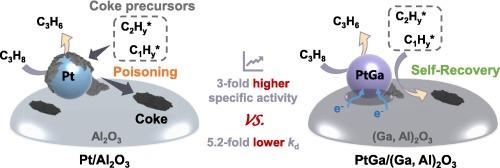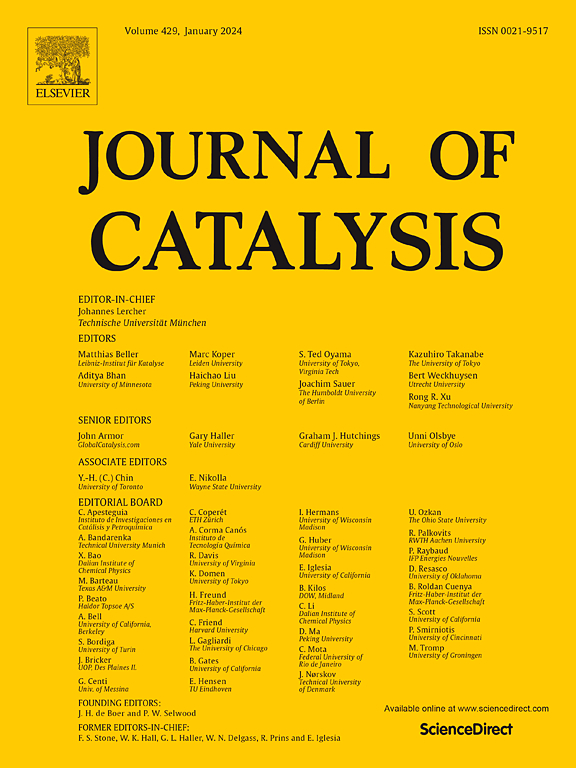Electron-driven self-recovery of PtGa bimetallic sub-nanoclusters for enhanced propane dehydrogenation stability
IF 6.5
1区 化学
Q2 CHEMISTRY, PHYSICAL
引用次数: 0
Abstract
Supported PtM bimetallic cluster catalysts exhibit excellent activity in propane dehydrogenation (PDH), owing to the synergistic effects of metal species. However, suppressing the poisonous inactivation of the active sites in harsh environments while preserving their robust activity remains a challenge. In this study, we propose a strategy to mitigate the active sites deactivation and enhance PtGa sub-nanocluster stability via promoting the desorption of coke precursors. As a result, the sub-nanometer PtGa cluster catalyst dispersed by Ga (III) Lewis sites exhibits outstanding specific activity and deactivation constant (kd). The kinetic and in situ DRIFTS characterizations suggest that the competitive adsorption of H2 and C3H8 on the Pt–Gaδ+ site at the Pt–GaAlOx interface optimizes the C–H bond activation. The electron-rich Pt facilitates the migratory behaviors of C1, C2, and hydrogen species through electron-transfer effects from partially reduced GaOx species, thereby facilitating the timely recovery of active sites and contributing to the stability of propane dehydrogenation.


电子驱动 PtGa 双金属亚纳米团簇自我恢复,提高丙烷脱氢稳定性
本文章由计算机程序翻译,如有差异,请以英文原文为准。
求助全文
约1分钟内获得全文
求助全文
来源期刊

Journal of Catalysis
工程技术-工程:化工
CiteScore
12.30
自引率
5.50%
发文量
447
审稿时长
31 days
期刊介绍:
The Journal of Catalysis publishes scholarly articles on both heterogeneous and homogeneous catalysis, covering a wide range of chemical transformations. These include various types of catalysis, such as those mediated by photons, plasmons, and electrons. The focus of the studies is to understand the relationship between catalytic function and the underlying chemical properties of surfaces and metal complexes.
The articles in the journal offer innovative concepts and explore the synthesis and kinetics of inorganic solids and homogeneous complexes. Furthermore, they discuss spectroscopic techniques for characterizing catalysts, investigate the interaction of probes and reacting species with catalysts, and employ theoretical methods.
The research presented in the journal should have direct relevance to the field of catalytic processes, addressing either fundamental aspects or applications of catalysis.
 求助内容:
求助内容: 应助结果提醒方式:
应助结果提醒方式:


